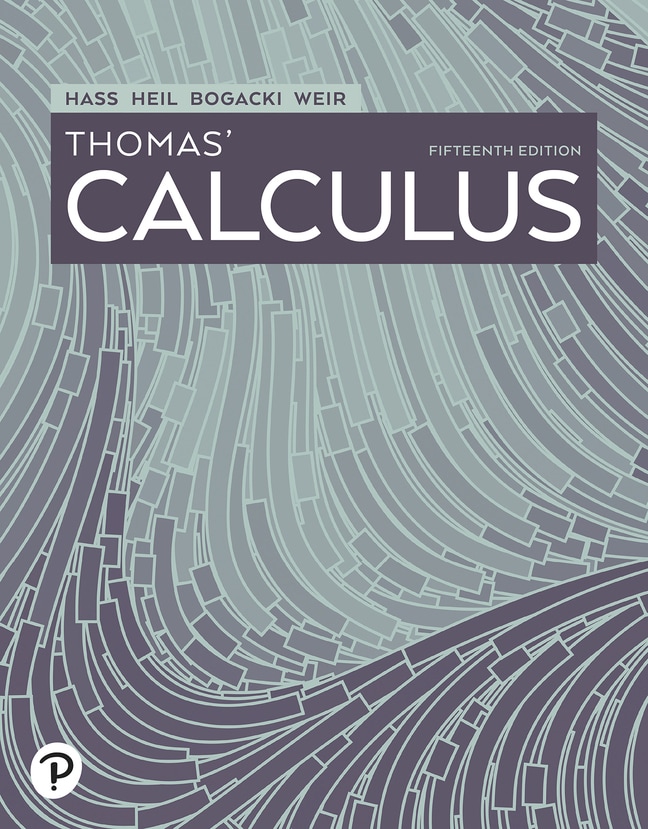
Thomas' Calculus, 15th edition
- Joel R. Hass
- , Christopher E. Heil
- , Maurice D. Weir
- , Przemyslaw Bogacki

- Find it fast
Quickly navigate your eTextbook with search
- Stay organized
Access all your eTextbooks in one place
- Easily continue access
Keep learning with auto-renew
Thomas' Calculus goes beyond memorizing formulas and routine procedures to help you develop deeper understanding. It guides you to a level of mathematical proficiency, with additional support if needed through its clear and intuitive explanations, current applications and generalized concepts. Technology exercises in every section use the calculator or computer for solving problems, and Computer Explorations offer exercises requiring a computer algebra system like Maple or Mathematica. The 15th Edition adds exercises, revises figures and language for clarity, and updates many applications; new online chapters cover Complex Functions, Fourier Series and Wavelets.
Published by Pearson (December 29th 2022) - Copyright © 2023
ISBN-13: 9780137616077
Subject: Calculus
Category: Calculus
- Functions
- 1.1 Functions and Their Graphs
- 1.2 Combining Functions; Shifting and Scaling Graphs
- 1.3 Trigonometric Functions
- 1.4 Graphing with Software
- Limits and Continuity
- 2.1 Rates of Change and Tangent Lines to Curves
- 2.2 Limit of a Function and Limit Laws
- 2.3 The Precise Definition of a Limit
- 2.4 One-Sided Limits
- 2.5 Continuity
- 2.6 Limits Involving Infinity; Asymptotes of Graphs
- Derivatives
- 3.1 Tangent Lines and the Derivative at a Point
- 3.2 The Derivative as a Function
- 3.3 Differentiation Rules
- 3.4 The Derivative as a Rate of Change
- 3.5 Derivatives of Trigonometric Functions
- 3.6 The Chain Rule
- 3.7 Implicit Differentiation
- 3.8 Derivatives of Inverse Functions and Logarithms
- 3.9 Related Rates
- 3.10 Linearization and Differentials
- Applications of Derivatives
- 4.1 Extreme Values of Functions on Closed Intervals
- 4.2 The Mean Value Theorem
- 4.3 Monotonic Functions and the First Derivative Test
- 4.4 Concavity and Curve Sketching
- 4.5 Applied Optimization
- 4.6 Newton's Method
- 4.7 Antiderivatives
- Integrals
- 5.1 Area and Estimating with Finite Sums
- 5.2 Sigma Notation and Limits of Finite Sums
- 5.3 The Definite Integral
- 5.4 The Fundamental Theorem of Calculus
- 5.5 Indefinite Integrals and the Substitution Method
- 5.6 Definite Integral Substitutions and the Area Between Curves
- Applications of Definite Integrals
- 6.1 Volumes Using Cross-Sections
- 6.2 Volumes Using Cylindrical Shells
- 6.3 Arc Length
- 6.4 Areas of Surfaces of Revolution
- 6.5 Work and Fluid Forces
- 6.6 Moments and Centers of Mass
- Transcendental Functions
- 7.1 Inverse Functions and Their Derivatives
- 7.2 Natural Logarithms
- 7.3 Exponential Functions
- 7.4 Exponential Change and Separable Differential Equations
- 7.5 Indeterminate Forms and L'Hôpital's Rule
- 7.6 Inverse Trigonometric Functions
- 7.7 Hyperbolic Functions
- 7.8 Relative Rates of Growth
- Techniques of Integration
- 8.1 Using Basic Integration Formulas
- 8.2 Integration by Parts
- 8.3 Trigonometric Integrals
- 8.4 Trigonometric Substitutions
- 8.5 Integration of Rational Functions by Partial Fractions
- 8.6 Integral Tables and Computer Algebra Systems
- 8.7 Numerical Integration
- 8.8 Improper Integrals
- 8.9 Probability
- First-Order Differential Equations
- 9.1 Solutions, Slope Fields, and Euler's Method
- 9.2 First-Order Linear Equations
- 9.3 Applications
- 9.4 Graphical Solutions of Autonomous Equations
- 9.5 Systems of Equations and Phase Planes
- Infinite Sequences and Series
- 10.1 Sequences
- 10.2 Infinite Series
- 10.3 The Integral Test
- 10.4 Comparison Tests
- 10.5 Absolute Convergence; The Ratio and Root Tests
- 10.6 Alternating Series and Conditional Convergence
- 10.7 Power Series
- 10.8 Taylor and Maclaurin Series
- 10.9 Convergence of Taylor Series
- 10.10 Applications of Taylor Series
- Parametric Equations and Polar Coordinates
- 11.1 Parametrizations of Plane Curves
- 11.2 Calculus with Parametric Curves
- 11.3 Polar Coordinates
- 11.4 Graphing Polar Coordinate Equations
- 11.5 Areas and Lengths in Polar Coordinates
- 11.6 Conic Sections
- 11.7 Conics in Polar Coordinates
Appendix A
- A.1 Real Numbers and the Real Line
- A.2 Mathematical Induction
- A.3 Lines, Circles, and Parabolas
- A.4 Proofs of Limit Theorems
- A.5 Commonly Occurring Limits
- A.6 Theory of the Real Numbers
- A.7 The Distributive Law for Vector Cross Products
- A.8 The Mixed Derivative Theorem and the Increment Theorem
Appendix B (online)
- B.1 Determinants
- B.2 Extreme Values and Saddle Points for Functions of More than Two Variables
- B.3 The Method of Gradient Descent